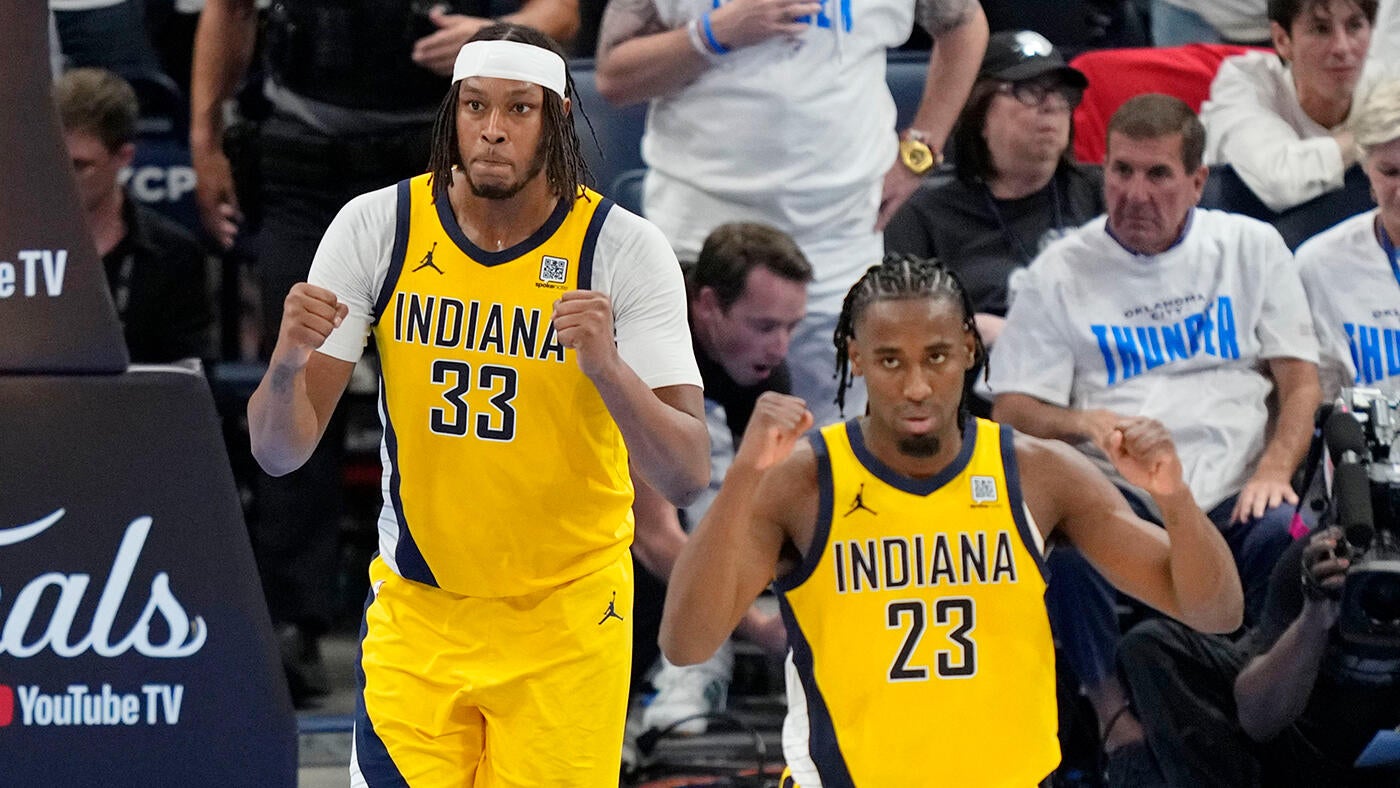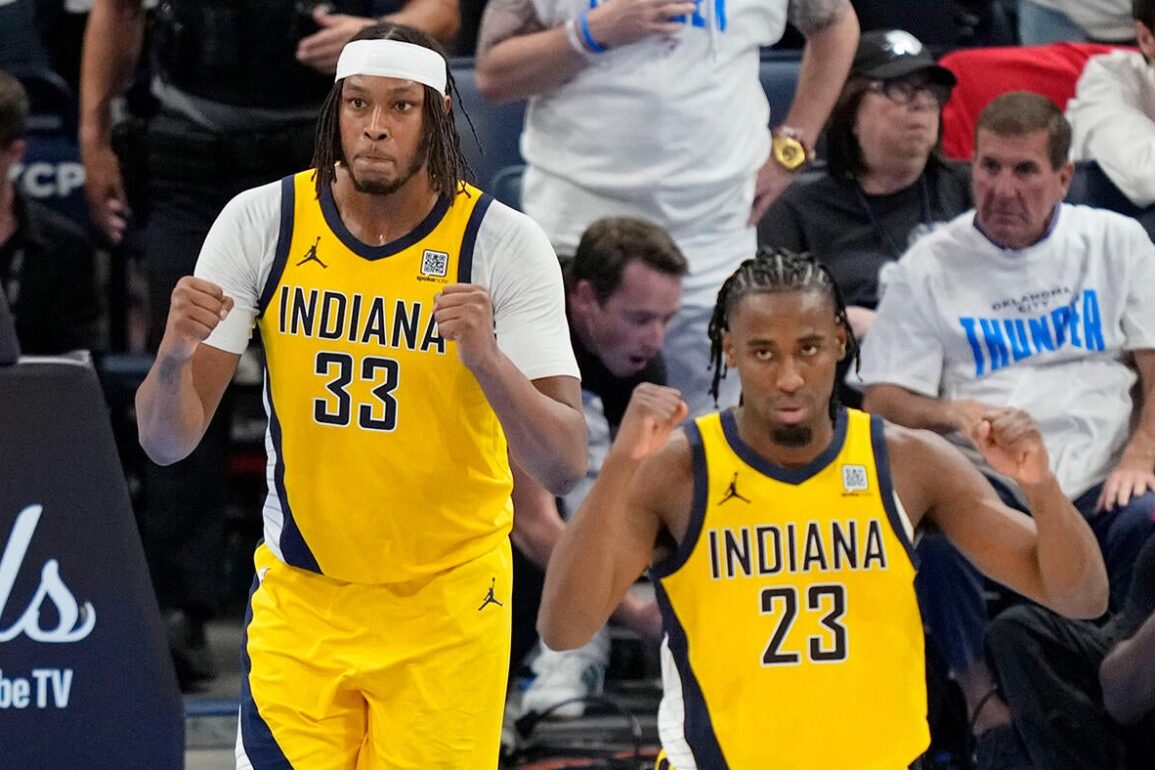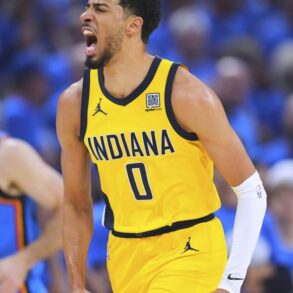The Oklahoma City Thunder were the better basketball team for about 45 minutes of Game 1 in the NBA Finals against the Indiana Pacers. Through the entire first half, the Thunder executed with elite precision, showing on the grandest of NBA stages why this team was heavily favored to be crowned champions. The defense was smothering. Shai Gilgeous-Alexander was earning every “MVP” chant. OKC made Indiana’s typically fast-paced, frenetic offense look like they forgot how to play basketball altogether.
But regardless of how dominant a team is, it hasn’t seemed to matter when they’re playing against the Pacers. Climbing back from a 15-point deficit, Tyrese Haliburton hit a go-ahead jumper with 0.3 seconds left in the game to give Indiana a 111-110 win in Game 1 on Thursday to take a 1-0 series lead. The usually raucous fans inside Paycom Center fell silent as they became the latest victims of Haliburton and Indiana’s late-game heroics.
NBA Finals: Pacers found their offense after a disastrous start to Game 1, now it’s OKC’s turn to do the same
James Herbert

It’s an incredibly tough pill for the Thunder to swallow, but not too much time can be spent wallowing in Thursday’s defeat. Oklahoma City has to turn the page to Game 2 on Sunday and learn from the mistakes made if they want to even up this series. As OKC tries to shake the feeling of Game 1 off, here are three keys for them to bounce back and flip the script on Indiana.
1. Converting turnovers into points
Had the Thunder not blown the game down the stretch, the biggest story of this would’ve been about OKC’s suffocating ball pressure and Indiana’s unpreparedness for that. Through the first half, the Pacers committed 20 turnovers, an absurd number that would seem fake if you didn’t watch the game. But the first two quarters were littered with shining examples of how stressful it can be to play against a defensive unit that employs a slew of players who could serve as the entirety of one All-Defensive team by themselves.
Indiana just couldn’t score in its halfcourt offense, and any time they tried to create a scoring opportunity, there were one or two OKC defenders right there ready to swipe at the ball. It’s the kind of team-wide defensive performance that would give opponents nightmares had this game gone in favor of OKC. But even with all the steals, deflections and general chaos the Thunder’s defense caused, they only carried a 12-point lead into halftime. That’s because despite forcing the Pacers to turn the ball over 20 times in the first half, OKC only generated nine points off those turnovers.
“I thought our conversion on the turnovers in the first half hurt us a little bit,” Thunder coach Mark Daigneault said following the loss. “Like, we didn’t get the kind of juice for that squeeze that we normally do when we turn teams over. We can take a look at that.”
A lot of the turnovers were dead-ball ones, meaning an offensive foul was called, the ball went out of bounds, or a player stepped out, so it limited OKC from getting out in transition to get easy points. But still, the Thunder shot the ball 19 more times than the Pacers did, and yet couldn’t capitalize on it. That has to change in Game 2, because the Pacers are customarily a low turnover team, so when you get an opportunity like the first half presented on Thursday night, OKC has to take advantage of that. Indiana took far better care of the ball in the second half — only five turnovers — and managed to hang around long enough to make a run in the closing minutes and win the game.
2. Holmgren and Williams need to find a rhythm
It was a teamwide issue, but part of the reason the Thunder struggled to convert on those turnovers was that the offense was just sputtering for most of the game. They shot around 40% from the field, and while they did have a decent shooting night from 3-point range, most of that was because of Luguentz Dort and Gilgeous-Alexander, who combined to go 8-15 from deep. The rest of the team went 3-15. Jalen Williams went 1 for 4 and on the night went 6-19 from the field. That level of inefficiency isn’t going to cut it against a Pacers team that performs well in clutch situations.
The same goes for Holmgren, who, on low shot volume (nine attempts), made just two of them. All but one of Holmgren’s shots were right at the rim, he just wasn’t able to convert. Credit Indiana’s defense, specifically Myles Turner who did a great job of defending Holmgren without fouling — an issue he had against the Knicks.
Turner has the strength advantage against Holmgren, so he basically just stonewalled the Thunder big man all night. And when Holmgren elevated for a shot, Turner was right there to challenge it.
“I feel like we were getting really good cracks at it, getting good looks, getting advantages,” Holmgren said. Especially myself, just wasn’t finishing those plays. Got to slow down and look how I can kind of convert those.”
The Thunder will have to figure out how to create different opportunities for Holmgren because trying to go straight at Turner isn’t going to be the answer. Pulling Turner away from the basket and forcing him to defend in space is probably the answer, and it worked on one of the two shots Holmgren made Thursday night.
Turner still managed to recover well despite Holmgren getting the angle on the Pacers’ big man, but Holmgren was able to finish through the contact, something he’ll have to keep doing in this series.
For Williams, it wasn’t that he was taking bad shots; he just couldn’t knock them down. The same goes for pretty much everyone else on the team. The Pacers deserve some credit, but in that first half, OKC really just struggled to hit some wide-open looks. So, going into Game 2, they’re going to need guys like Williams and Holmgren to find more consistency so a repeat of Thursday night doesn’t happen again.
3. Small ball may not be the answer
Daigneault raised some eyebrows when it was announced that the Thunder would be making a switch to their starting lineup, bringing in Cason Wallace for Isaiah Hartenstein. It was a chess move from the Thunder, opting for a smaller lineup out of the gate to better matchup against an Indiana team that has the ability to space the floor 5-wide thanks to Turner’s ability to shoot 3s. Having Wallace on the floor instead of Hartenstein also gives OKC more speed and quickness to contend with the Pacers’ fast-paced offense.
While it made sense on paper, and for large portions of the game, it did work, the Thunder got absolutely manhandled on the glass, with Indiana having a +17 advantage.
“I thought getting Cason [Wallace] out there really defensively, giving us another perimeter guy for Haliburton and Nembhard, that was the idea there,” Daigneault said.
In the first half, having Wallace, in addition to Dort and Alex Caruso, had an impact on Indiana, which was struggling to get things going offensively. But on the flip side of that, the Pacers were able to hunt mismatches with Wallace on Pascal Siakam, who had no issue attacking Wallace in the post.
Not having Hartenstein out there for long stretches of time also meant Siakam could either throw his weight around more when crashing the glass, leading to second-chance points:
Or there wasn’t a big lurking under the rim to grab a rebound for this play when Gilgeous-Alexander gets caught sleeping, which allowed Siakam to cut backdoor for an easy putback:
Siakam wasn’t able to exploit the mismatch that much for Daigneault to leave that small-ball lineup. In fact, the Thunder’s closing lineup excluded both Holmgren and Hartenstein, with Wallace and Caruso taking their place. But if OKC continues with that strategy in this series, the Pacers could look to feed Siakam the ball and let him go to work against smaller defenders.
Fortunately, the Thunder are great at responding after losing a game this postseason. They haven’t lost back-to-back games at any point in the playoffs, and have only lost multiple games in a row twice during the regular season. That tells us OKC will make the necessary adjustments to respond in a major way for Game 2.
This post was originally published on this site be sure to check out more of their content.








